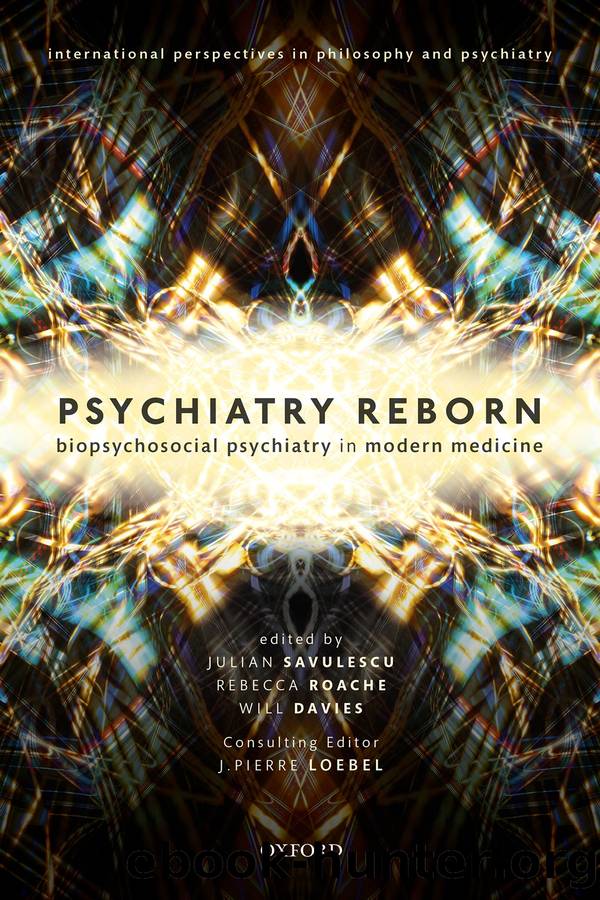Psychiatry Reborn: Biopsychosocial Psychiatry in Modern Medicine by Will Davies;Julian Savalescu;Rebecca Roache;J. Pierre Loebel;

Author:Will Davies;Julian Savalescu;Rebecca Roache;J. Pierre Loebel;
Language: eng
Format: epub
Publisher: Oxford University Press USA
Published: 2020-06-15T00:00:00+00:00
The role of expectations
There is evidence for many psychological illnesses that the symptoms presented are influenced by the patientâs expectations. One extreme of this comes with psychosomatic illness: here it may be that the entire nature of the symptoms is determined by the patientâs expectations. We need not venture into cases as extreme as these, but can focus on those where the expectations have some impact on the symptoms. Here are two examples, which vary in the degree of controversy they will elicit.
Shell-shock.First World War shell-shock produced a wide range of symptoms, some of which have been much less noticeable in other conflicts: witness the many kinds of odd gait that were remarked on by doctors at the time.2 There is good evidence that at least some of these were affected by the attitudes of the patients. For instance, in their comparison of patients in Berlin and London, Linden and Jones found that functional seizures were over three times more common in the former group than the latter. Various factors could explain this, but they concluded that the most likely were cultural; more crudely put, that the German patients were more likely to expect to suffer seizures (Linden and Jones, 2014, pp. 542â4).3
Eating disorders.This is a more controversial case, but there is some reason to think that the particular form that eating disorders take is affected by the expectations of those who suffer from them. First, there is the issue of change over time. For many years it was thought that rates of anorexia nervosa increased dramatically from the 1960s until at least the 1990s. More careful studies called that into question, and rates from around 1990 look to be fairly steady.4 But there does seem to have been a strong increase in the incidence of bulimia nervosa: that rose threefold in the period from the early 1980s to the end of the century (Currin et al., 2005; Hudson et al., 2007). Second, there is the issue of cross-cultural change. The best documented here is a set of studies by Lee Sing concerning anorexia in Hong Kong. Lee contends that a form of anorexia existed in the Chinese population but that it was very different to that seen in the Westâit wasnât characterized by unhappiness about being overweight, nor was it connected with an unrealistic body image. This changed, he thinks, in the mid 1990s when a Western idea of anorexia was introduced (partly by journalists and by well-meaning public health official alarmed at the lack of preventative programmes), so that now most sufferers conform much more closely to those in the West. If eating disorders change across time and culture, an obvious explanation is that this is mediated by the attitudes of those involved.5
Other examples could be givenâthe increased prevalence of cutting among Western adolescents6; the rise, and decline, of multiple personality disorder7; the presentation of depression in cultures like Japan (Kitanaka, 2012). And there are many historical cases. All are somewhat controversial but all seem to show some evidence of an impact on the symptoms of the expectations of the subjects.
Download
This site does not store any files on its server. We only index and link to content provided by other sites. Please contact the content providers to delete copyright contents if any and email us, we'll remove relevant links or contents immediately.
Application of a Novel Technique for Clinical Evaluation of Nitric Oxide-Induced Free Radical Reactions in ICU Patients by Unknown(696)
Rosenâs Emergency Medicine Concepts and Clinical Practice by Ron Walls; Robert Hockberger; Marianne Gausche-Hill; Timothy B. Erickson; Susan R. Wilcox(572)
Oxidative damage to surfactant protein D in pulmonary diseases by Vitality Starosta1 & Matthias Griese1†(408)
Social Science Perspectives on Global Public Health by Vincent La Placa & Julia Morgan(374)
Constructing Canine Consent; Conceptualising and Adopting a Consent-focused Relationship with Dogs by ERIN JONES(330)
Organic Chemistry: An Acid - Base Approach by MICHAEL SMITH(299)
ADVANCED EMERGENCY CARE AND TRANSPORTATION OF THE SICK AND INJURED by Unknown(271)
Saunders Nursing Drug Handbook 2024 - E-Book by Unknown(263)
Socio-Life Science and the COVID-19 Outbreak : Public Health and Public Policy by Makoto Yano; Fumihiko Matsuda; Anavaj Sakuntabhai; Shigeru Hirota(247)
Diagnostic and Statistical Manual of Mental Disorders, Fifth Edition, Text Revision (DSM-5-TR(tm)) by Unknown(246)
Davis's Comprehensive Manual of Laboratory and Diagnostic Tests with Nursing Implications by Unknown(245)
Human Microanatomy; Cell Tissue and Organ Histology with Celebrity Medical Histories by Stephen A. Stricker(244)
Berne and Levy Physiology E-Book by Unknown(235)
Handbook of Skin Disease Management by Jiyad Zainab;Flohr Carsten; & Carsten Flohr(229)
Replacing the Dead by Mie Nakachi;(229)
Access to Medicines and Vaccines in the South : Coherence of Rules and Policies Applied by the European Union Commission by Stephen Kingah(226)
Deep Learning and Medical Applications by Unknown(220)
The Pocket Guide to Sensorimotor Psychotherapy in Context (Norton Series on Interpersonal Neurobiology) by Pat Ogden(218)
Advances and Technical Standards in Neurosurgery by Unknown(215)
